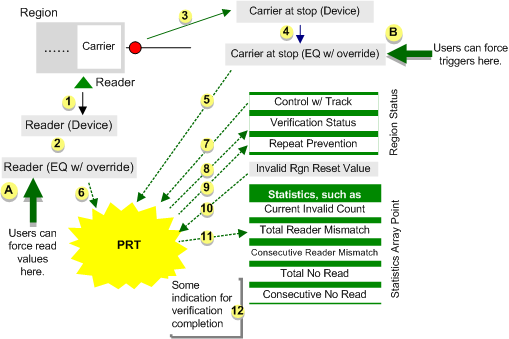An assumption for this system is that there can only be one carrier between the reader and the head of the region when PRT is triggered for the existence of a carrier at the head of that region. This will eliminate the timing problems that can arise in different circumstances.
A carrier passes by the reader at the head of a region.
|
The value of the read (if there is any) is copied to a device point that is configured for that reader |
|
|
This value is then copied into a an Equation with override derived point for the reader |
|
|
|
At this point the equation with override derived point types are only available for analog points. This design allows users to configure analog points for the reader values. These points are then converted to ASCII for internal processing using a region specific C formatting string supplied in the configuration. This derived point will be the mechanism to manually enter the correct reader values if necessary. After giving the system enough time to get the complete read in to the device point, a trigger notifies the PRT subsystem about the new item at the head of the region |
|
The trigger is usually a limit switch at the head of the region, which acts as a carrier at head indicator. |
|
|
|
The trigger value is copied into a derived point similar to the reader point |
|
The derived point provides a mechanism to re-trigger the PRT validation process. |

|
Changes in the derived trigger point trigger PRT. |
|
|
PRT retrieves the latest value of the reader and (7) the configuration for the region on how to proceed with the validation. |
|
|
After the validation process is completed PRT updates the results of the process (8)(9) and updates some runtime statistics (11). |
|
|
After the validation process is completed, the PRT subsystem should provide a mechanism for letting other subsystems know about the completion of the validation process. |
|
|
|
This would help eliminate the timing issues that might arise between the PRT validation process and the processes (such as RCO s or an event manager driven routing mechanism) that may act on the validity of regions after the validation process has completed. Since validation statistics are going to be updated after every validation, this point will be used to trigger other processes. |
|
Automated region validation. |